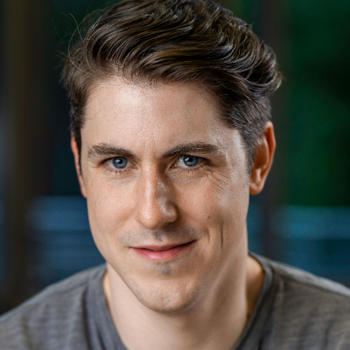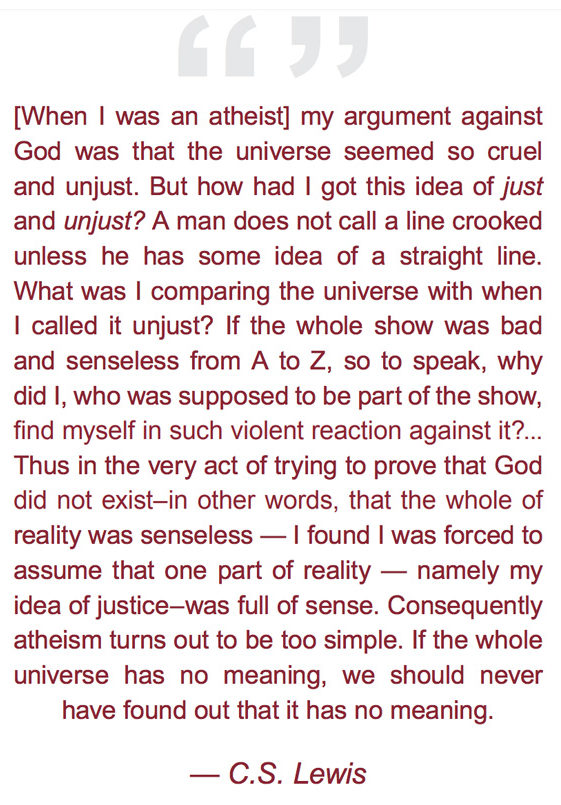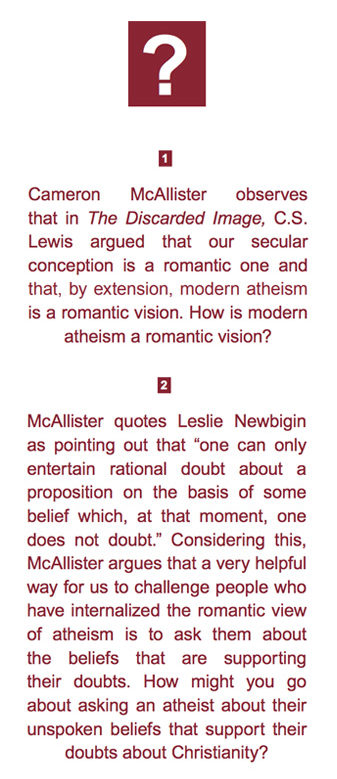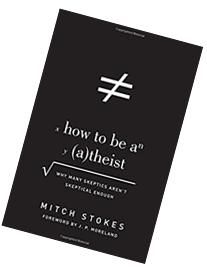Back to series


Recommended Reading:

Download or Listen to Audio
The Glamour of Atheism
Click here to open a Print - Friendly PDF
Though the title of this article risks overstatement, I hope the reader will, with courtesy, not regard it as a cheap ploy for attention. My aim is simple: I want to make the case that overlooking atheism’s appeal constitutes a serious strategic mistake for those of us who want to discuss the gospel with skeptics. Christians are frequently accused of wishful thinking, of taking shelter from reality behind the walls of the church. Though this is clearly a double-edged sword — wishful thinking works both ways — my reason for focusing on the glamour of atheism is not to craft a rejoinder but to train a lens on a frequently overlooked issue. Atheism, like any belief system, makes a loud appeal to the imagination. If we overlook this striking fact, we turn a blind eye to one of the key sources of its persuasive power.
 Augustine of Hippo first gave systematic expression to the notion that human beings are defined primarily by what they love. He left no stone unturned in his summation:
Augustine of Hippo first gave systematic expression to the notion that human beings are defined primarily by what they love. He left no stone unturned in his summation:
He is also a [just and holy] person who has ordered his love, so that he does not love what it is wrong to love, or fail to love what should be loved, or love too much what should be loved less (or love too little what should be loved more), or love two things equally if one of them should be loved either less or more than the other, or love things either more or less if they should be loved equally.
1Recently the philosopher James K.A. Smith has recovered this central line of Augustinian thought in his three-volume Cultural Liturgies series.
2My work as a frontline Christian apologist often predisposes me to think that, contra Augustine, human beings are defined primarily by what they think and that the world is to be understood as a massive confluence of ideas rather than as arena of competing (and frequently disordered) loves. But I’ve come to see that this isn’t always the case. What changed my mind? First, a growing conviction that most human action owes its lifeblood to deep-seated desire, not to ideas alone. Are we merely chasing ideas in movie theaters, concert halls, and sports arenas? Smith suggests that your chances of getting to know someone are pretty slim if you ask only about what that person thinks. Ask people about what they want, however, and you’ll gain a whole new level of insight into their character and personality. Notice that this head-heart disparity is also one way to account for the frequent discrepancy between a person’s beliefs and actions. If you really want to know what a person believes, look at what they do — not what they say. This is why Augustine suggests that we lead with our hearts, not our heads. Pascal offers a striking confirmation with one of his best-known quotations: “The heart has its reasons of which reason knows nothing.”
Confronting the substance of atheism’s arguments remains vitally important, but we make a serious strategic mistake if we don’t also consider what makes people want to be atheists in the first place.
Toward a Pretheoretically Understanding of Culture
Getting away from our cerebral understanding of human action is easier said than done. Think about the cherished place that worldview thinking occupies in apologetic circles, for instance. As a concept, worldview is extraordinarily helpful in disclosing the logical entailments of someone’s deeply held convictions. But it encounters serious limitations when we try to push it beyond its status as a heuristic device. Stated bluntly, most people don’t see their experience of life as a “worldview,” and they usually don’t employ its conceptual language when they open up about their views. This point was recently driven home to me when I was speaking at a major American university. A friend who was part of our team was fond of worldview maps — questionnaires meant to clarify a person’s major assumptions by assigning them to a corresponding worldview — and he would eagerly foist these surveys on any student who would give him the time of day. He always came back saying the same thing: “These people are all over my map! There’s just no consistency.”
It gradually dawned on me that the map — not the students — was the problem. In a highly perceptive maneuver, the Canadian philosopher Charles Taylor argues that our experience of life is less like a map, and more like the deeply ingrained familiarity of our neighborhood. When it comes to the places we live — the sights, the smells, the sounds — we know them in our very bones; they are indelible fixtures in our consciousness. But it often happens that we can’t translate this intimate knowledge into the conceptual language of a map.3 Before the advent of Google maps, many of us faced a common dilemma when people stopped to ask us for directions in the places we knew the best. We could take them to the desired location; we were powerless to rattle off the necessary street names and distances for them to reach their destination. Another example would be the odd confusion that sets in when a spouse or close friend asks us to say one of our many passwords out loud. We learn very quickly that saying it out loud is not the same thing as typing it out on a phone or computer; it often takes a keyboard or a simulated motion to bring the information into the open air. Many of us also draw a blank when we’re asked to give a step-by-step recitation of a family recipe. The problem is that we’ve internalized this knowledge so deeply that only a kitchen and the necessary ingredients can release it. Paradoxically there are some things we know too well to articulate. This same dilemma was transpiring between my friend and the unsuspecting students. It’s not that they didn’t know what they believed; it’s that they knew it too well to put it into words.
 Taylor employs the term social imaginary to describe this pretheoretically experience of the circumstances of our lives. It’s a useful way to understand the odd disconnect that takes place when we ask people to translate these experiences into theoretical terms. While it’s true, for instance, that a large number of college students are by default hedonists, few of them would describe their spring-break escapades with this kind of textbook terminology. As Taylor says, “Humans operated with a social imaginary, well before they ever got into the business of theorizing about themselves.”4 Smith is right: if you ask these same students about what they hoped to get out of spring break, you’ll be on your way to a much deeper conversation.
Taylor employs the term social imaginary to describe this pretheoretically experience of the circumstances of our lives. It’s a useful way to understand the odd disconnect that takes place when we ask people to translate these experiences into theoretical terms. While it’s true, for instance, that a large number of college students are by default hedonists, few of them would describe their spring-break escapades with this kind of textbook terminology. As Taylor says, “Humans operated with a social imaginary, well before they ever got into the business of theorizing about themselves.”4 Smith is right: if you ask these same students about what they hoped to get out of spring break, you’ll be on your way to a much deeper conversation.
As apologists, we want to help people articulate what they know too deeply to say out loud. True, part of that task does involve offering conceptual language that matches a person’s unvoiced assumptions, but first we need to locate the pretheoretically forces that shape our common understanding in the first place. Though the term social imaginary is not original to Taylor, he is using both words in a somewhat idiosyncratic manner: As social creatures, our environment intimately shapes us, but the structure of this environment is primarily imaginative, and it is “carried in images, stories, legends, etc.”5 This is why overhearing these cultural narratives can be so helpful to us as apologists. In order to do that, however, we need to become more adept at receiving culture in imaginative terms, because, according to Taylor, our views are shaped more by stories than they are by static messages and ideas. In this sense, popular culture can tell us a lot about how we see ourselves. What do recent films such as Love, Simon — a teen coming-out-story — and Every Day — a story about a sixteen-year-old girl who falls in love with a spirit that inhabits a different body every day — say about our understanding of love and what it means to be human?
We might also ask what stories our culture is telling us about atheism. Look no further than my friends Fox and Dana. Fox is imaginative and intensely open-minded. He’s fond of cryptozoology, paranormal activity, and alien abduction stories. His basement office has a poster of a UFO with “I want to believe” printed at the bottom.
Dana isn’t like my friend Fox, though. Trained as a medical doctor, she’s skeptical and scientific-minded. She wants only the facts, and she doesn’t hide behind conspiracy theories when she can’t come up with a reasonable explanation.
Okay, these aren’t my friends; they’re FBI agents Fox Mulder and Dana Scully from the television series The X-Files. I bring them into the conversation because their characters function almost like modern archetypes of the believer and the skeptic. The analogy breaks down a bit, because the show continues to complicate their roles, but my basic point is this: there’s a largely unvoiced assumption running through North American culture that skeptics are smart, honest, and tough-minded, and that believers are fragile, credulous, and gullible. It’s by no means self-evident that skepticism is a guarantee of higher intelligence, but that doesn’t change the fact that many of us are immediately on our guard if we hear that a skeptic is going to be chatting with us about our beliefs. This assumption is one example of the pretheoretically picture that emerges when we listen to a dominant narrative in our culture. It also happens to be part and parcel of atheism’s social imaginary. Think about atheist philosopher Daniel C. Dennett’s use of the term brights to characterize all the enlightened individuals who espouse atheism.
6Part of popular atheism’s appeal has to do with its largely unquestioned reputation as the default position of the highly intelligent. It goes without saying that this assumption is neither self-evident nor rational; there are plenty of nonbright skeptics, of course. Instead, it’s part of atheism’s pretheoretically story. If you quiz someone on why they think atheists are smarter than Christians and religious people, they often just blink at you as though the answer is self-evident. Major personalities like Carl Sagan, Neil deGrasse Tyson, and the late Stephen Hawking may flash before their minds. In other words, atheism’s cultural capital is highly imaginative. It’s amazing how a seemingly innocuous designation like “brights” can shape public perception. But it does.
The Romantic Vision of Atheism
 In The Discarded Image, C.S. Lewis makes a counterintuitive point about modern atheism. Contrasting contemporary and medieval mindsets about humanity’s place in the cosmos, he argues that our secular conception is a romantic one and that, by extension, modern atheism is a romantic vision.7 Ironically, my initial response to this assertion was skepticism. Is there really anything romantic in the claim that all of reality is the result of a cosmic accident? How could such a barren vision possibly be romantic?
In The Discarded Image, C.S. Lewis makes a counterintuitive point about modern atheism. Contrasting contemporary and medieval mindsets about humanity’s place in the cosmos, he argues that our secular conception is a romantic one and that, by extension, modern atheism is a romantic vision.7 Ironically, my initial response to this assertion was skepticism. Is there really anything romantic in the claim that all of reality is the result of a cosmic accident? How could such a barren vision possibly be romantic?
Interestingly, literary scholar M.H. Abrams’s landmark study of romantic literature, The Mirror and the Lamp, corroborates Lewis’s view. The respective images of the lamp and the mirror serve as two dominant metaphors for the mind’s interaction with the world, and Abrams traces them back to two ancient thinkers: “If Plato was the main source of the philosophical archetype of the reflector, Plotinus was the chief begetter of the archetype of the projector; and both the romantic theory of knowledge and the romantic theory of poetry can be accounted the remote descendants of this root image of Plotinian philosophy.”8 Thus for the modern romantics, the “perceiving mind is that of a lamp projecting light,” rather than the mirror passively receiving and reflecting the contours of our world.9 This move from reflecting to projecting amounts to a “Copernican revolution in epistemology,” because it means that the world is no longer viewed as an established order to which we must conform but, rather, as a vast blank canvas awaiting our masterstroke.10 In effect, “the mind discovers what it has itself partly made.”
11According to Abrams, the main culprits behind this revolution were critics and poets, not academics.12 Here we have yet another example of how public perception is shaped by imagination. For better or for worse, modern secularism internalized this radical vision of human creative power and autonomy. This is partly why the default assumption of everything from Disney movies to a thinker like Steven Pinker is that humanity is now the master of its own destiny. This is the romantic vision of popular atheism. True, it can yield a picture of humans as cosmic orphans waylaid on this small planet in a barren universe. But it can also portray us as cosmic crusaders, taking our fate into our own hands and reshaping the world to fit our own desires. As outlandish as this may sound, it happens to be the very ambition of many highly influential thinkers. Have a look at Nick Bostrom’s “Transhumanist Values” for a particularly striking example.13
Doubt and Its Supporting Beliefs
 Rather than offer a systematic critique of popular atheism, I’d like to leave you with a helpful challenge for skeptics. Lesslie Newbigin once pointed out, “one can only entertain rational doubt about a proposition on the basis of some belief which, at that moment, one does not doubt.”14 Despite its current prestige, doubt remains inextricably dependent on belief. You can believe without doubting, but you can never doubt without belief. If I begin to suspect that the two seemingly benevolent caretakers who have always identified themselves as my mom and dad are in fact impostors, it goes without saying that I didn’t begin with this suspicion. No child begins by doubting its parents’ identity.
Rather than offer a systematic critique of popular atheism, I’d like to leave you with a helpful challenge for skeptics. Lesslie Newbigin once pointed out, “one can only entertain rational doubt about a proposition on the basis of some belief which, at that moment, one does not doubt.”14 Despite its current prestige, doubt remains inextricably dependent on belief. You can believe without doubting, but you can never doubt without belief. If I begin to suspect that the two seemingly benevolent caretakers who have always identified themselves as my mom and dad are in fact impostors, it goes without saying that I didn’t begin with this suspicion. No child begins by doubting its parents’ identity.
Notice also that my skepticism regarding the identity of my parents depends on a series of unvoiced beliefs — namely, the existence of authentic parents, my ability to reason and properly interpret the evidence against the perceived impostors, and so on. Consequently I think a very helpful way for us to challenge people who have internalized the romantic view of atheism is to ask them about the beliefs that are supporting their doubts. If every doubt depends upon a prior belief, it makes a lot of sense to ask about whether that particular belief makes sense of our experience of reality. We want to ask skeptics to follow their doubts back to their bedrock beliefs.
Naturally, atheists strongly doubt the existence of God. But, as we’ve seen, that doubt rests on a host of unstated beliefs. In my experience, atheists are often unwilling to discuss these beliefs, so this is a conversation that may require some patience. With regard to atheism’s romantic picture of the world, I think it’s worth asking about the extremely high estimation of human nature on display in this view. Popular atheism places a very high premium on human reason, arguing that this faculty will one day enable us to usher in a world largely devoid of today’s myriad imperfections. I once had a two-hour conversation with a student at a secular university about whether or not human nature was perfectible. This student was convinced that war, poverty, racism, economic disparity, and all social ills would one day be nothing more than memories — that benevolent scientists would one day wipe away every tear. With this in mind, I think a very helpful question would be: “Given what you see in our world today, do you think that reason will solve all of our problems? Has all of our technological progress made the world a better place? Is there a strong correlation between reason and moral behavior? Can we solve the riddle of human nature?” These are sobering questions and honest answers can take you in some surprising directions with those outside the church.
The glamour of atheism is as romantic as it is compelling. In our conversations with men and women who have been captivated by this vision, let’s be prepared to ask them about the unspoken beliefs that support their doubts about Christianity. In so doing, we’ll be helping them to articulate what they know too deeply to say out loud. Once something is said out loud, a whole new level of clarity is possible. As we read in Mark’s Gospel, “For everything that is hidden will eventually be brought into the open, and every secret will be brought to light” (4:22 NLT).
|
Notes: |
|||

Cameron McAllister
Author and SpeakerCameron McAllister is a content director for Reflections Ministries. He cofounded Thinking Out Loud, where he’s a speaker, writer and one half of the Thinking Out Loud podcast, a weekly podcast about current events and Christian hope. He and his father co-authored Faith That Lasts: A Father and Son on Cultivating Lifelong Belief. A staff writer with Christ & Pop Culture, Cameron’s writing has appeared in Christianity Today, Relevant Magazine, Think Christian, and Fathom Magazine. He holds a master’s degree in apologetics from Houston Baptist University. Cameron and his wife Heather live in the Atlanta area with their two children.

Recommended Reading:
Mitch Stokes, How to Be an Atheist: Why Many Skeptics Aren’t Skeptical Enough (Crossway, 2016)
Atheists talk a lot about the importance of skepticism. But the truth is, they’re not nearly skeptical enough.
While atheists champion the importance of a critical stance toward religion, they often fail to take that same stance toward their own beliefs. This double standard results in grandiose claims about the certainty of their unbelief — which is logically inconsistent at best and intellectually dishonest at worst. Turning atheists’ skepticism around on their own naturalist worldview, philosopher Mitch Stokes critically examines two things that such skeptics hold dear — science and morality — and reveals deep inconsistencies among their most cherished beliefs, inconsistencies that threaten to undo atheism itself.
 COPYRIGHT: This publication is published by C.S. Lewis Institute; 8001 Braddock Road, Suite 301; Springfield, VA 22151. Portions of the publication may be reproduced for noncommercial, local church or ministry use without prior permission. Electronic copies of the PDF files may be duplicated and transmitted via e-mail for personal and church use. Articles may not be modified without prior written permission of the Institute. For questions, contact the Institute: 703.914.5602 or email us.
COPYRIGHT: This publication is published by C.S. Lewis Institute; 8001 Braddock Road, Suite 301; Springfield, VA 22151. Portions of the publication may be reproduced for noncommercial, local church or ministry use without prior permission. Electronic copies of the PDF files may be duplicated and transmitted via e-mail for personal and church use. Articles may not be modified without prior written permission of the Institute. For questions, contact the Institute: 703.914.5602 or email us.
-
Recent Podcasts
The Road Back – Trevor Lancon’s Story
by Trevor Lancon, Jana Harmon on November 15, 2024Deeply involved in his church’s youth group, Trevor...Read More
-
From Politics to Pampers
by Michelle Morgan Knott, Aimee Riegert on November 15, 2024
-
An Unexpected Change – David Westerhoff’s Story
by David Westerhoff on November 8, 2024
-
Recent Publications
Will You Be Ready?
by Thomas A. Tarrants on October 23, 2024Tom Tarrants gives insights on how we can...Read More
-
Should Christians Be Involved with Politics?
by Kerry A. Knott on October 1, 2024
-
Isn ’t Atheism Based on Scientific Fact Whereas Christianity is Based on “Faith”?
by Cameron McAllister on September 1, 2024
0
All Booked
0.00
All Booked
0.00
All Booked
23169
ADVENT CALENDAR: The Amazing Prophecies Fulfilled by the Birth of Jesus Christ
https://www.cslewisinstitute.org/?event=advent-calendar-the-amazing-prophecies-fulfilled-by-the-birth-of-jesus-christ&event_date=2024-11-28®=1
https://www.paypal.com/cgi-bin/webscr
2024-11-28

Next coming event
Days
Hours
Minutes
Seconds
ADVENT CALENDAR: The Amazing Prophecies Fulfilled by the Birth of Jesus Christ
On November 28, 2024 at 6:00 amSpeakers

Cameron McAllister
Author and Speaker
Team Members

Cameron McAllister
Author and SpeakerCameron McAllister is a content director for Reflections Ministries. He cofounded Thinking Out Loud, where he’s a speaker, writer and one half of the Thinking Out Loud podcast, a weekly podcast about current events and Christian hope. He and his father co-authored Faith That Lasts: A Father and Son on Cultivating Lifelong Belief. A staff writer with Christ & Pop Culture, Cameron’s writing has appeared in Christianity Today, Relevant Magazine, Think Christian, and Fathom Magazine. He holds a master’s degree in apologetics from Houston Baptist University. Cameron and his wife Heather live in the Atlanta area with their two children.






